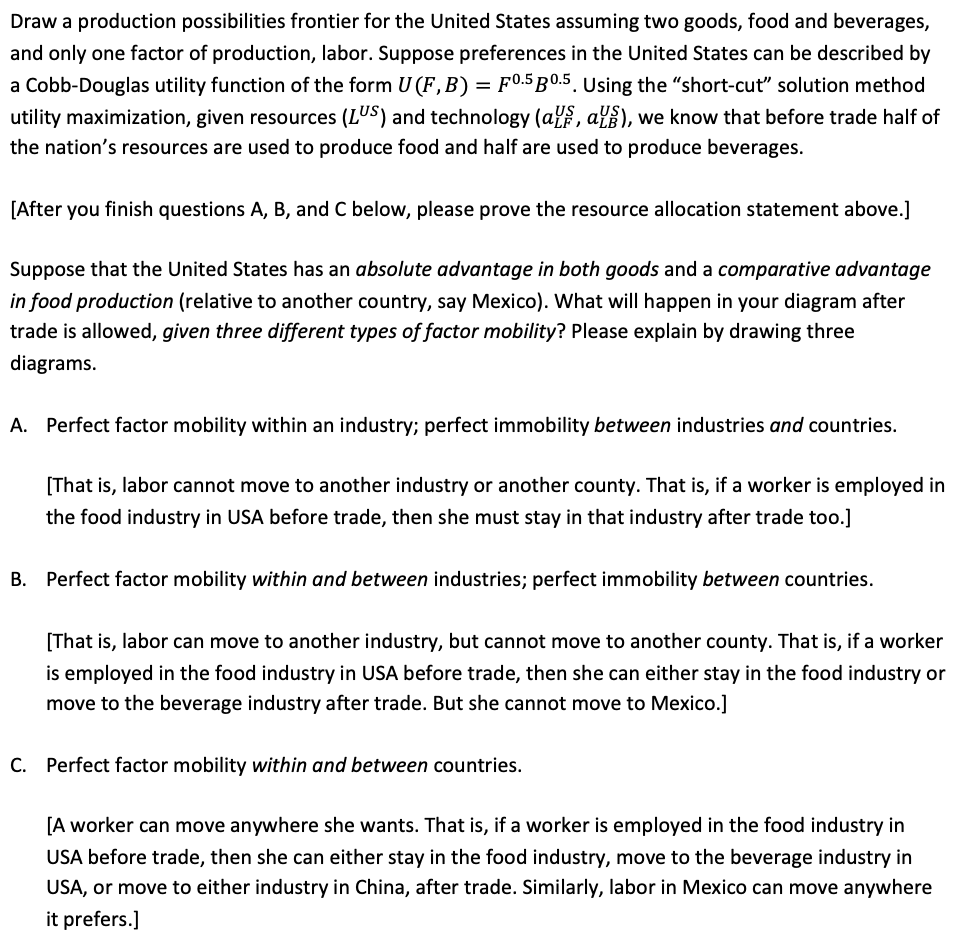 Please answer Questions A-C, Asap
Please answer Questions A-C, Asap
Draw a production possibilities frontier for the United States assuming two goods, food and beverages, and only one factor of production, labor. Suppose preferences in the United States can be described by a Cobb-Douglas utility function of the form U(F,B) = 70.580.5. Using the short-cut solution method utility maximization, given resources (LUS) and technology (ays, als), we know that before trade half of the nation's resources are used to produce food and half are used to produce beverages. [After you finish questions A, B, and C below, please prove the resource allocation statement above.] Suppose that the United States has an absolute advantage in both goods and a comparative advantage in food production (relative to another country, say Mexico). What will happen in your diagram after trade is allowed, given three different types of factor mobility? Please explain by drawing three diagrams. A. Perfect factor mobility within an industry; perfect immobility between industries and countries. [That is, labor cannot move to another industry or another county. That is, if a worker is employed in the food industry in USA before trade, then she must stay in that industry after trade too.] B. Perfect factor mobility within and between industries; perfect immobility between countries. (That is, labor can move to another industry, but cannot move to another county. That is, if a worker is employed in the food industry in USA before trade, then she can either stay in the food industry or move to the beverage industry after trade. But she cannot move to Mexico.] C. Perfect factor mobility within and between countries. [A worker can move anywhere she wants. That is, if a worker is employed in the food industry in USA before trade, then she can either stay in the food industry, move to the beverage industry in USA, or move to either industry in China, after trade. Similarly, labor in Mexico can move anywhere it prefers.] Draw a production possibilities frontier for the United States assuming two goods, food and beverages, and only one factor of production, labor. Suppose preferences in the United States can be described by a Cobb-Douglas utility function of the form U(F,B) = 70.580.5. Using the short-cut solution method utility maximization, given resources (LUS) and technology (ays, als), we know that before trade half of the nation's resources are used to produce food and half are used to produce beverages. [After you finish questions A, B, and C below, please prove the resource allocation statement above.] Suppose that the United States has an absolute advantage in both goods and a comparative advantage in food production (relative to another country, say Mexico). What will happen in your diagram after trade is allowed, given three different types of factor mobility? Please explain by drawing three diagrams. A. Perfect factor mobility within an industry; perfect immobility between industries and countries. [That is, labor cannot move to another industry or another county. That is, if a worker is employed in the food industry in USA before trade, then she must stay in that industry after trade too.] B. Perfect factor mobility within and between industries; perfect immobility between countries. (That is, labor can move to another industry, but cannot move to another county. That is, if a worker is employed in the food industry in USA before trade, then she can either stay in the food industry or move to the beverage industry after trade. But she cannot move to Mexico.] C. Perfect factor mobility within and between countries. [A worker can move anywhere she wants. That is, if a worker is employed in the food industry in USA before trade, then she can either stay in the food industry, move to the beverage industry in USA, or move to either industry in China, after trade. Similarly, labor in Mexico can move anywhere it prefers.]
 Please answer Questions A-C, Asap
Please answer Questions A-C, Asap





